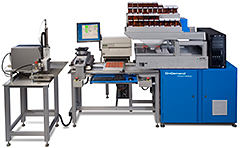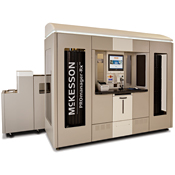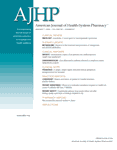The PharmaTrust MedCentre is a fully automated remote dispensing machine similar to the InstyMeds Prescription Medication Dispenser I mentioned back in October of 2009. We were evaluating the InstyMeds machine when it died a slow agonizing death during budget talks.
The idea is simple really. Load the MedCentre machine with a few hundred of the most commonly prescribed medications in ready to dispense, pre-packaged bottles, have a patient insert a prescription, or “voucher” depending on what country or state you’re in, and sit back and wait for the prescription to pop out. Just like a vending machine. Of course the patient has the option to consult a pharmacist by simply picking up a telephone attached to the machine, but I don’t assume that happens too often. Most people want their medications as quickly as possible.
(more…)
 In a previous
In a previous  A friend from
A friend from  a single patient quickly and accurately and in a fraction of the time it would take to do it manually. This pharmacy automation equipment system utilizes a custom interface to work with your existing information systems, enabling automated workflow management in the pharmacy. This single data input process reduces input time and the possibility of data entry errors. OnDemand ® 400 for RxMap ® uses bar-code technology to accurately dispense multiple medications into one compartment – as many or as few as needed. RxMap ® Adherence Packs vary in size and shape to meet the needs of the customers you serve. The finished product is a patient – specific adherence package filled “just-in-time†for your customer.
a single patient quickly and accurately and in a fraction of the time it would take to do it manually. This pharmacy automation equipment system utilizes a custom interface to work with your existing information systems, enabling automated workflow management in the pharmacy. This single data input process reduces input time and the possibility of data entry errors. OnDemand ® 400 for RxMap ® uses bar-code technology to accurately dispense multiple medications into one compartment – as many or as few as needed. RxMap ® Adherence Packs vary in size and shape to meet the needs of the customers you serve. The finished product is a patient – specific adherence package filled “just-in-time†for your customer.
